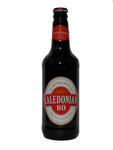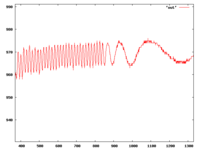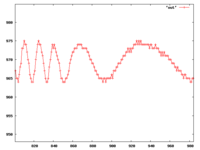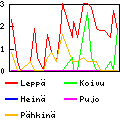Mercredi, 30 décembre 2009
Catégories : [ Livres ]

Ragle Gumm vit dans les années 50 avec sa s½ur et son beau-frère. Ragle tire
son revenu d'un concours organisé par le quotidien local, un jeu abstrait où
il s'agit de trouver à quel endroit le martien se posera la prochaine fois.
Mais Ragle a des visions bizarres, des impressions de déjà-vu. Un jour il
essaye de quitter sa petite ville, mais il est capturé par des soldats et se
retouve chez lui ; ce que lui raconte son entourage ne cadre pas avec ses
propres souvenirs. Avec l'aide de son beau-frère ils finissent par réussir à
quitter la ville et découvrent un pays en ruines suite à des bombardements
nucléaires ; ils ne sont pas dans les années 50 mais à la fin des annés 90.
Ils apprennent que les bombardements sont le fait des colons humains sur la
Lune qui se rebellent contre le parti au pouvoir qui veut abandonner les
colons. Ragle était la seule personne capable de prévoir la prochaine cible
des missiles. Lorsqu'il s'est replié sur lui même et que son esprit est parti
dans les années 50 de son enfance, le gouvernement a construit une réplique
d'une ville de cette époque et a inventé le concours du journal. À la fin,
Ragle décide de se ranger du coté des colons, car sans son aide, les terriens
seront obligés de capituler (ce qu'ils avaient songé à faire au début de la
guerre avant de découvrir les capacités de Ragle).
[ Posté le 30 décembre 2009 à 14:19 |
pas de
commentaire |
lien permanent ]
Adresse de trackback
https://weber.fi.eu.org/blog/Livres/le_temps_desarticule.trackback
Commentaires
Aucun commentaire
Lundi, 28 décembre 2009
Catégories : [ Livres ]

© Amazon.fr
Dan Davis, inventeur en 1970 de robots domestiques à tout faire se rend compte
qu'il a été escroqué par ses deux partenaires, Miles et Belle, sa fiancée, qui
s'est en fait secrètement mariée à Miles. Presque sans le sou, il décide
d'hiberner pendant trente ans et de voir l'an 2000. La veille du début de sa
cure de sommeil, il rend visite à Miles et Belle et se fait droguer par cette
dernière qui falsifie ses documents et l'envoie en sommeil dans une autre
compagnie. À son réveil en 2000, l'entreprise à qui Belle avait confié ses
avoirs a fait faillite, et Dan se retrouve sans le sou. De plus, Frederica, la
fille adoptive de Miles qui a sept ans et que Dan aimait beaucoup et à qui il
voulait confier ses actions, a été spoliée aussi et est introuvable à cette
époque. De plus, Belle est devenue vieille, droguée et sans le sou. Dan finit
par se faire reconnaître comme l'inventeur des robots à tout faire, qui sont
devenus très courants, et se fait engager comme objet de marketing par
l'entreprise qui les commercialise. Il en profite pour mettre ses
connaissances à jour, et découvre qu'il existe deux machines dont il a eu
l'idée la veille de son sommeil qui portent des numéros de brevets qui ont été
déposés à son nom en 1970. Un de ses collègues avec qui il s'entend bien lui
apprend que le voyage dans le temps existe (un application dérivée de
l'anti-gravité, d'utilisation courante), mais qu'il est couvert par le secret
militaire, et qu'en plus la direction du voyage (vers le passé ou l'avenir)
est aléatoire. Dan réussit cependant à retrouver le scientifique qui l'avait
mis au point et à le convaincre de l'envoyer dans le temps. Par chance, il
revient en 1970, quelques mois avant avant le début de son sommeil et
rencontre au moment de son « aterrissage » un avocat avec qui il devient
ami. Dan dessine les plans des deux appareils dont il avait eu l'idée, puis
les confie à son ami avec ordre de les breveter et de fonder une compagnie
pour produire l'un d'entre eux. Il confie ensuite des papiers de valeur à
Frederica, puis retourne hiberner à nouveau pendant 30 ans. À son second
réveil en l'an 2000, il retrouve Frédérica qui est s'est mise en sommeil aussi
peu après sa majorité pour se réveiller en 2000, et se marient.
[ Posté le 28 décembre 2009 à 17:48 |
pas de
commentaire |
lien permanent ]
Adresse de trackback
https://weber.fi.eu.org/blog/Livres/une_porte_sur_l_ete.trackback
Commentaires
Aucun commentaire
Dimanche, 27 décembre 2009
Catégories : [ Livres ]

© Amazon.fr
Recueil de quatre nouvelles de Poul Anderson, publié en 1960.
La patrouille du temps: Manse Everard est membre de la Patrouille du temps,
une police de l'Histoire mise en place par les Daneeliens, descendants des
humains qui vivent un million d'années dans le futur, et qui tiennent à
s'assurer, après la découverte du voyage temporel, que personne ne modifie
l'Histoire au point d'empêcher leur existence. Dans cette première aventure,
un homme veut modifier l'Histoire de l'Angleterre en 464 afin d'empêcher la
décadence des Saxons et l'absorption de l'Angleterre par le monde occidental.
Il veut unifier le monde du futur derrière l'Angleterre afin de forcer une
paix mondiale et mettre fin aux guerres. Lors de leur retour à leur temps de
départ, Whitcomb, le compagnon d'Everard, se rend en 1944 dans l'espoir
d'empêcher la mort de sa fiancée dans un bombardement de Londres, ce qui est
interdit par les règles de la Patrouille. Everard se lance à sa poursuite pour
l'aider ; en menaçant de révéler au public de 1947 l'existence de la
Patrouille, il obtient de rencontrer un Daneelien qui accorde à Whitcomb et à
sa fiancée d'aller vivre dans l'Angleterre victorienne.
Le grand roi: Everard part en Perse antique à la recherche d'un
patrouilleur perdu. Il découvre que ce dernier est devenu le grand roi Cyrus,
personnage clé de l'Histoire, qui a reigné seize ans lorsqu'Everard le
retrouve. La légende de Cyrus veut que ce dernier aurait dû être tué alors
qu'il était un bébé, mais que son exécuteur aurait eu pitié de lui et l'aurait
confié à une famille de bergers qui l'aurait élevé avant qu'il ne revienne
réclamer son trône. Le bébé a effectivement été tué et le patrouilleur perdu
est apparu au bon moment pour prendre la place de Cyrus. Everard retourne au
moment moment où Cyrus bébé doit être tué et, se faisant passer pour un dieu,
ordonne que le bébé soit confié à une famille de bergers. Le patrouilleur
perdu peut alors rentrer chez lui.
Échec aux Mongols: Everard et un patrouilleur Navajo sont envoyés en 1280
pour empêcher des Mongols qui avaient débarqué au Canada de préparer
l'invasion de l'Amérique du Nord, ce qui aurait chamboulé l'Histoire en
y instaurant une civilisation Mongolo-Indienne avant la découverte par
Christophe Colomb. Les Mongols n'étant jamais retourné en Asie, à Everard de
les en empêcher. Les tentatives d'intimidations ayant échoué, Everard finit
par détruire leurs navires et tuer leurs chevaux, les décourangeant ainsi
de continuer.
L'autre univers: Après des vacances dans une station de ski de la Patrouille
dans les Pyrénnées du Pléistocène, Everard et Van Sarawak retournent à New
York en 1955, mais découvrent que le monde a complètement changé : la
civilisation est mi-celte, mi-sémitique, née du renversement de l'Empire
Romain par les Celtes. Ils finirent par apprendre que Scipion l'Africain a été
tué lors de la deuxième guerre punique, et que la troisième n'a jamais eu
lieu. Ayant réussi à s'échapper vers le passé, ils tentent de rappeler tous
les Patrouilleurs avant de partir à l'époque de Scipion. Ils découvrent que
deux malfaiteurs du 205è millénaire sont responsables, et parviennent à les
arrêter avant qu'ils ne provoquent la mort de Scipion.
[ Posté le 27 décembre 2009 à 20:50 |
pas de
commentaire |
lien permanent ]
Adresse de trackback
https://weber.fi.eu.org/blog/Livres/la_patrouille_du_temps.trackback
Commentaires
Aucun commentaire
Catégories : [ Livres ]

© Amazon.fr
Roman de Robert Heinlein, publié en 1956.
Le Grand Lorenzo, un acteur au chômage, est embauché pour jouer le rôle de
Bonforte, un important politicien qui a été enlevé quelques jours avant sa
cérémonie d'adoption par la plus importante famille Martienne, un pas
extrêmement important avant une alliance entre Mars et l'Empire Terrien.
L'étiquette martienne étant très stricte et complexe, il n'est pas
envisageable de ne pas se présenter à un rendez-vous. Après une longue étude
du personnage et avec l'aide des membres de l'équipe de Bonforte, Lorenzo
réussit donc à jouer le rôle de Bonforte à la perfection. Peu après la
cérémonie, le véritable Bonforte est libéré par ses ravisseurs (qui sont à la
solde du parti au pouvoir, opposé à l'alliance avec Mars) mais ces derniers
lui ont lavé le cerveau. Lorenzo continue donc de jouer le rôle du politicien
au cours de diverses apparition à la télévision. Lorsque l'état de Bonforte
empire, mais que son parti gagne les éléctions et que le politicien devient le
nouveau Premier Ministre, Lorenzo rencontre l'empereur pour lui présenter sa
proposition de gouvernement. L'empereur, qui connait Bonforte depuis des
années perce le déguisement de Lorenzo, mais après avoir entendu toute
l'histoire, souhaite bonne chance à Lorenzo. Lorsque plus tard Bonforte
décède, Lorenzo prend définitivement la place du politicien, avec le support
de l'équipe de Bonforte.
[ Posté le 27 décembre 2009 à 20:49 |
pas de
commentaire |
lien permanent ]
Adresse de trackback
https://weber.fi.eu.org/blog/Livres/double_etoile.trackback
Commentaires
Aucun commentaire
Mardi, 22 décembre 2009
Traduction: [ Google | Babelfish ]
Catégories : [ Bière/Caledonian ]

“crystal malt and roast barley… hand cradted… using Britain's last
remaining direct-fired open coppers.”
Sweet and with a hint of some kind of red fruit. Contains malted barley.
Caledonian Brewery, Edinburgh, Scotland. 4.1% alcohol.
[ Posté le 22 décembre 2009 à 21:12 |
pas de
commentaire |
lien permanent ]
Adresse de trackback
https://weber.fi.eu.org/blog/Biere/Caledonian/caledonian_80.trackback
Commentaires
Aucun commentaire
Catégories : [ Livres ]

© Amazon.fr
De l'article Vendredi (roman) de Wikipedia:
Vendredi est le nom de l'héroïne, une jeune femme « génétiquement
construite », ce qui en fait un agent secret particulièrement redoutable.
Employée comme coursière pour porter des microfilms, elle sera capturée,
torturée et violée dès le début de l'histoire. Sauvée par son employeur,
Vendredi passera des vacances dans un groupe familial qu'elle fréquente en
Nouvelle-Zélande. Les groupes familiaux sont composés de gens aux m½urs
échangistes qui vivent en communauté. Sollicité pour s'engager plus
sérieusement avec eux, Vendredi est rejetée au premier désaccord. Elle se sent
brimée parce qu'elle a un besoin d'avoir un semblant de vie familiale qu'elle
n'a jamais connue. Vendredi aura une liaison avec un pilote canadien dont le
groupe familial est plus accueillant. À son retour en Amérique du Nord, une
crise politique l'empêche de retourner au travail. Une grande partie du roman
montre les efforts de Vendredi pour retrouver son employeur. Elle traverse les
anciens États-Unis qui sont morcelés en différents pays dont les idéologies
sont antagonistes et de toute façon, ce sont les multinationales qui mènent.
Retrouvée par son employeur, Vendredi est employée comme une sorte de génie
intuitif capable de corréler des données a priori sans rapport. Elle prévoit
une épidémie de peste. Son employeur mort, elle ira à Las Vegas où on la
recrutera comme courrier pour porter un ovule afin que la fille d'un dictateur
puisse donner naissance à un héritier. Elle découvrira qu'on a fait d'elle une
mère porteuse, Vendredi désertera sur une planète coloniale et retrouvera ses
amis canadiens.
[ Posté le 22 décembre 2009 à 13:10 |
1
commentaire |
lien permanent ]
Adresse de trackback
https://weber.fi.eu.org/blog/Livres/vendredi.trackback
Commentaires
Ahhhh...
Commentaire N° 1, tth (Morangis, France)
le 4 janvier 2010 à 10:11
Samedi, 19 décembre 2009
Traduction: [ Google | Babelfish ]
Catégories : [ Bière/Brains ]

“A nutty richness derived from a blend of pale and crystal malts is
balanced with a dryness from the use of three hops: Challenger, Goldings and
Fuggles. The aroma has a hint of spirit…”
Just another ale. Contains barley and wheat.
S.A. Brain & Co. Ltd., The Cardiff Brewery, Cardiff, Wales. 4.2% alcohol.
[ Posté le 19 décembre 2009 à 20:20 |
pas de
commentaire |
lien permanent ]
Adresse de trackback
https://weber.fi.eu.org/blog/Biere/Brains/brains_sa.trackback
Commentaires
Aucun commentaire
Jeudi, 17 décembre 2009
Traduction: [ Google | Babelfish ]
Catégories : [ TV/Cinéma/Star Trek ]

Wikipedia
Spock's half-brother Sybok, who decided to follow his feelings rather than logic,
has kidnapped a Terran, Romulan and Klingon embassadors on a planet in the
Neutral Zone in order to attract a Federation starship (the new, unfinished
Enterprise) and take it over. He manages to convince the crew and especially
its captain, Kirk, to take him to the center of the galaxy, inside the Great
Barrier to a planet believed to be the craddle of all life in the galaxy, and
where God might be living. The entity they meet is rather evil and not a god
at all, and the heroes eventually manage to escape the planet after Sybok was
is killed by the entity, thanks to the help of a Klingon Bird of Prey which
was following the Enterprise in an personal attempt by its captain to gain
honor by defeating Kirk.
[ Posté le 17 décembre 2009 à 11:18 |
pas de
commentaire |
lien permanent ]
Adresse de trackback
https://weber.fi.eu.org/blog/TV/Cinema/Star_Trek/star_trek_5.trackback
Commentaires
Aucun commentaire
Dimanche, 6 décembre 2009
Traduction: [ Google | Babelfish ]
Catégories : [ Livres/Discworld ]

© Amazon.fr
Moist von Lipwig, a con artists, is condemned to be hanged, but his death is
faked by the Patrician who puts him in charge of Ankh-Morpork's Post Office
which has been closed for many years. With the help of an old Postman who
still lives in the building and his assistant, they start by delivering the
tons of mail which had been accumulated in the building, filling most rooms
and corridors. Moist hires golems as postmen, because they work without
interruption and don't mind dog bites. Meanwhile, the Grand Trunk Company, who
had acquired the clacks network in dubious circumstances and is running it
without pause nor maintenance in order to make the most money out of it,
doesn't like the Post Office to be reopened. But since the Grand Trunk is
prohibitively expensive and ceases functioning at least once a week, people
start to use mail again. Moist invents the post stamp, which turns out to be
very lucrative when people start collecting stamps. Moist also discovers that
parts of the failures of the Grand Trunk are caused by the “Smoking Gnu”,
which turns out to be a group of three crackers who have found a way to break
clacks towers by sending a specific message, and not the spirit of the dead
clacksmen after all. In the end, Moist challenges the Grand Trunk Company to
send a message to Genua, two-thousand miles away. By mail coach it will take
a couple of months, but Moist manages to get the people to support him. Thanks
to the Smoking Gnu, he also manages to replace the message sent to Genua by
clacks with a text of his own, accusing the Company to have swindled the
creators of the clacks. There is no actually proof, but the message received
in Genua is read by a wizard over a kind of magical television system during
an official reception at the University and everyone can hear the accusation,
which is enough for the Patrician to order a financial investigation.
[ Posté le 6 décembre 2009 à 19:12 |
1
commentaire |
lien permanent ]
Adresse de trackback
https://weber.fi.eu.org/blog/Livres/Discworld/going_postal.trackback
Commentaires
Dimanche, 29 novembre 2009
Traduction: [ Google | Babelfish ]
Catégories : [ Livres/Wodehouse ]

© Amazon.fr
Published in 1925.
Jeeves Takes Charge Bertie hires Jeeves. Engaged to Florence Craye, the
latter forces Bertie to steal a manuscript written by her uncle Willoughby the
content of which reveals the agitated youth of, among other prominent figures,
her father. Jeeves saves Bertie by removing the parcel, hidden in his master's
room, before the uncle searches it, and forwarding it to the publisher,
causing Florence to break her engagement to Bertie.
The Artistic Career of Corky Bertie fled to New York to avoid meeting his
Aunt Agatha. There, his artist friend Corky seeks Bertie's help to find a way
to present Muriel Singer, the actress to whom he's engaged to Alexander
Worple, his uncle, a bird specialist who also gives him a regular allowance.
Jeeves suggests Muriel to write a children's book about birds, where she would
abundently quote Worple's books on birds. Muriel eventually marries old
Worple and gives birth to a child, depriving Corky from his inheritance. When
Worple asks him to paint a portrait of the baby, the result is quite
cartoonish and the uncle hates it, but it is the beginning of Corky's career
as a regular cartoonist.
Jeeves and the Unbidden Guest Lady Malvern, a friend of Aunt Agatha's, drops
her son at Bertie's before touring the American prisons for her new book. Her
son Motty is supposed to be of the quiet kind, but actually spends quite a
dissolute life in New York, ending up in prison. Her mother sees him there and
accuses Bertie of having neglected his duty as a guardian, but Jeeves saves
the day by making her believe that Motty went to prison voluntarily in order
to help her mother with her work.
Jeeves and the Hard-Boiled Egg Bertie's friend Bicky is in trouble, since
he's supposed to be a businessman in New York, while he's actually idle,
living from his uncle's allowance. Said uncle just arrives in New York; Jeeves
suggests Bertie to lend him his flat, since Bicky is supposedly rich. But this
only makes the uncle cut off his allowance. Bicky then decides to start a
chicken farm business, but needs some starting cash. Jeeves manages to find a
bunch of americans who would pay to shake hands with the uncle (who's the Duke
of Chiswick). The plot is discovered, but Jeeves manages to blackmail the
uncle into finding him a place as a secretary, against not telling the press
(that the uncle hates) about the incident.
The Aunt and the Sluggard Rockmetteller Todd the poet, yet another friend of
Bertie's, lives in the country on Long Island and hates the big city. When his
aunt promises him a large allowance against his frequent written account of
his supposedly tepidant life in New York, he turns to Jeeves who suggest that
himself could have the trepidant life and forward some notes Rocky could use to
write his reports to his aunt. One day, the aunt, who is supposed to hate
traveling, appears on Bertie's door (Rocky is supposedly writing from there)
and wants to live herself the excitement of the city. After several
excruciating days for Rocky, Jeeves manages to take the aunt to a religious
meeting where the orator accuses the city of all the sins. The aunt then
decides to return home and “forces” her nephew to retire to the country.
The Rummy Affair of Old Biffy While in Paris, Bertie is told by his friend
Biffy that he met a girl and got engaged on a ship to New York, but being a
real chump all he remembers of her is her name, Mabel. He is desperate
to find her again. Back in London, Biffy gets engaged to Honoria Glossop, and
Jeeves seems unable to help him. Bertie suggest him to make a fool of himself
during a lunch with Honoria's father, but he fails at it. While visiting an
exhibition in Wembley with Bertie and Jeeves, the former tells the latter what
Biffy had revealed in Paris. Jeeves suddenly suggests Biffy to visit a
pavillion where live mannequins are dressed as women from all over the world.
Biffy recognizes Mabel. Jeeves then explained that Mabel is his niece and he
thought Biffy only toyed with her feelings.
Without the Option To cheer up his friend Sippy, Bertie suggests him to
steal a policeman's helmet, but Sippy end up in prison under a false name.
Depending on his aunt's allowance, he doesn't want her to know his situation,
but since he has promised her to stay in Cambridge at her friend's place, he
cannot fail to show up. Jeeves suggests that Bertie shoild take his place,
since they haven't seen Sippy since he was ten. The family is terrible, the
daughter is a cousin of Honoria Glossop, and even looks and behaves like her.
Bertie's cover is blown the day Honoria's father comes to visit and recognizes
him. He manages to escape, and Jeeves suggests him to go and tell the truth to
Sippy's aunt. She laughs at what her nephew has done, because Jeeve's cousin,
being the policeman of the aunt's village, had started some weeks before to
force her to actually pay for offences (given her temper, it wasn't the case
before).
Fixing it for Freddie Freddie's fiancee Elizabeth has suddenly broken their
engagement. To cheer him up, Bertie takes him to the coast, but Elizabeth
happens to live in the same village. Bertie then decides to kidnap a kid who
seems to be Elizabeth's nephew so that Freddie could be a hero by returning
the missing child, but Elzabeth does not actually know him, she was just
playing with him on the beach. Bertie enventually finds the child's family,
but since they all got the mumps, they ask him to take care of him until his
uncle arrives from London. Jeeves then suggests to teach the kid to say “Kiss
Freddie” in Elizabeth's presence when given a candy in order to soften her.
The plot fails when Elizabeth discovers the child has been trained, but
somehow Freddie and her are engaged again.
Clustering Round Young Bingo Bingo asks Bertie to steal an article his wife
wrote for Aunt Dahlia's magazine, which would make all Bingo's friends laugh at
him. Bertie fails, but Jeeves manages to arrange for Bingo's cook to be hired
by Agatha (being the only cook who can soothe Uncle Tom's stomach, therefore
putting him in a good mood that allows Dahlia to ask him for money) in
exchanged for the article not to be published.
Bertie Changes his Mind (The story is told by Jeeves) Bertie decides he
doesn't want to be a bachelor anymore and wants to buy a house and live with
his sister and her children. Jeeves does not like the prospect. While driving
to Brighton they meet a twelve-years old girl whom they drive back to her
school. Jeeves convinces the headmistress to ask Bertie to make a speech in
front of all the girls. The experience his terrible for poor Bertie who
decides to stay a bachelor after all.
[ Posté le 29 novembre 2009 à 23:09 |
1
commentaire |
lien permanent ]
Adresse de trackback
https://weber.fi.eu.org/blog/Livres/Wodehouse/carry_on_jeeves.trackback
Commentaires
Very Good, Jeeves
Commentaire N° 1, Blog & White
le 10 mai 2010 à 22:32
Mardi, 24 novembre 2009
Catégories : [ Bricolage/Arduino ]
Le détecteur IR (QRB1134)
ne fonctionne pas très bien pour détecter le déplacement de l'aiguille du
compteur d'eau. Le fait qu'il y ait une couche de verre et que le compteur
soit sous eau ne doit probablement pas faire partie des paramètres normaux de
fonctionnement…
J'ai suivi le schéma à
superdroidrobots.com
pour le branchement, en ajoutant une LED rouge entre la résistance de
10 kΩ et le collecteur du phototransistor. L'Arduino n'a servi que comme
source de tension stabilisée.
L'émetteur IR a une tension de polarisation de 1,7 V et supporte jusqu'à
40 mA, il nécessite donc une résistance de 83 Ω. Avec 110 Ω, on
obtient 30 mA. J'ai utilisé deux résistances de 220 Ω en parallèle lors
du deuxième test.
Il faudrait essayer en utilisant une entrée analogique de l'Arduino et
observer les variations de tension au bornes du capteur pour voir si on arrive
à détecter le passage de l'aiguille.
[ Posté le 24 novembre 2009 à 21:43 |
pas de
commentaire |
lien permanent ]
Adresse de trackback
https://weber.fi.eu.org/blog/Bricolage/Arduino/detecteur_ir.trackback
Commentaires
Aucun commentaire
Vendredi, 20 novembre 2009
Traduction: [ Google | Babelfish ]
Catégories : [ Livres/Wodehouse ]

© Amazon.fr
Published in 1947.
Bertie meets by accident Florence Craye, to whom he once had been engaged. He
then meets his school friend Stilton Cheesewright who just got engaged to
Florence (and is very jealous). Jeeves then tells him that Lord Worplesdon,
Florence's father and second husband of Bertie's Aunt Agatha, had asked him to
go to his place at Steeple Bumpleigh to organise a secret meeting with
J. Chichester Clam, an american businessman. Bertie is additionally asked by
his friend Boko Fittleworth to help him getting Worplesdon's blessing to marry the
lord's ward, Nobby Hopwood. Boko being a writer, Worplesdon the businessman is
not going to give the permission easily, but since Worplesdon hates Bertie,
the latter has no idea how to plead for him. In Steeple Bumpleigh, Bertie and
Jeeves are given a cottage belonging to Worplesdon, which is going to be used
as the meeting place. Alas, as soon as Bertie arrives, the place is burned
down by Edwin, Worplesdon's pest of a son. One night, while Bertie was playing
the burglar in order to allow Boko to save the day and get the favours of the
Lord, the latter's meeting with Clam in the potting shed is aborted because
the american is confused with a robber. Jeeves then suggests to convince
Worplesdon and Clam to meet at the masked ball in the neighbouring town,
something made possible since Aunt Agatha is currently away. Meanwhile,
Florence gets angry at Stilton, and decides to get engaged to Bertie again,
which makes Stilton angry and Bertie nervous, Stilton being the local
policeman (a fact Florcence hates, since her father could have arranged for
him to become a member of Parliament, but Stilton wants to make his own
living). In trying to get Florence to break the engagement, Bertie kicks Edwin
(an action that had allowed Boko to get Florence to break her engagement with
him once), but Florence being annoyed by Edwin's latest actions finds this a
good thing; Worplesdon however witnesses the scene and gets suddenly fond of
Bertie. When Worplesdon finally manages to meet Clam at the ball and make
business with him, Boko uses the fact that he's in a good mood to get his
permission to marry Nobby. Eventually, Stilton resigns from the Police and
gets engaged to Florence again.
[ Posté le 20 novembre 2009 à 23:11 |
pas de
commentaire |
lien permanent ]
Adresse de trackback
https://weber.fi.eu.org/blog/Livres/Wodehouse/joy_in_the_morning.trackback
Commentaires
Aucun commentaire
Mardi, 17 novembre 2009
Traduction: [ Google | Babelfish ]
Catégories : [ TV/Cinéma/James Bond ]

Wikipedia
007 and 006 get trapped while planting explosives in a Sovietic chemical
weapons facility. 007 escapes, but 006 is killed. Nine years later, Bond
witnesses the theft of a new stealth helicopter, protected against
electromagnetic interference. Soon after, a Siberian radar station is
destroyed by an electromagnetic pulse, and satellite pictures reveal the
presence of the helicopter. The weapon used is the GoldenEye, made of two
one-time use satellites emiting such a pulse and destroying all electronics in
an area of tens of kilometers. One satellite remains, and the key to the
system has been stolen by a criminal known as Janus. Bond goes to St.
Petersburg to meet Janus (using Janus' competing crime lord as an
intermediary), and discovers him to be the Trevelyan, ex-006, who was a
traitor and not dead after all. With the help of the mandatory girl, the sole
survivor of the destruction of the Siberian station, Bond chases Trevelyan and
manages to learn that the control station for the second GoldeEye satellite is
in Cuba. Bond and the girl go there and manage to destroy the satellite before
it being used on London. Trevelyan's plan was to rob the Bank of England
electronically and then erase all traces with an electromagnetic pulse, at the
same time avenging his parents' death, victims of the Betrayal of the
Cossacks.
[ Posté le 17 novembre 2009 à 10:45 |
1
commentaire |
lien permanent ]
Adresse de trackback
https://weber.fi.eu.org/blog/TV/Cinema/James_Bond/goldeneye.trackback
Commentaires
Samedi, 14 novembre 2009
Traduction: [ Google | Babelfish ]
Catégories : [ Bière/Ridgeway ]

“sweet like California raisins, but bitter and pungent like a freshly peeled
grapefruit”
I'm not sure about the raisins, but the smell has something of grapes, the
taste is a bit grapefruity and quite bitter. Contains barley.
Ridgeway Brewing, Oxfordshire, England. 4.7% alcohol.
[ Posté le 14 novembre 2009 à 20:51 |
pas de
commentaire |
lien permanent ]
Adresse de trackback
https://weber.fi.eu.org/blog/Biere/Ridgeway/reindeer_droppings.trackback
Commentaires
Aucun commentaire
Mardi, 10 novembre 2009
Traduction: [ Google | Babelfish ]
Catégories : [ Livres/Wodehouse ]

© Amazon.fr
Published in 1923.
Bingo Little is once again in love, this time with a simple waitress. In order
for his uncle to accept her, Jeeves suggests to read him stories by Rosie M.
Banks which are full of such situations. To make it even more convincing,
Bingo tells his uncle that Wooster is in really Rosie M. Banks. Eventually,
the uncle marries his cook.
Aunt Agatha orders Bertie to join her in France, where she introduces him to a
priest and his sister, whom she thinks will be a perfect wife for Wooster. The
priest and the sister happen to be a pair of con artists who steal Agatha's
pearls. Thankfully, Jeeves recognizes them and manages to recover the pearls.
Bingo is in love again, this time with Honoria Glossop. In order to attract
her attention, he asks Wooster to take part in a scheme where Bertie would
throw Honoria's insufferable little brother in the river and he would rescue
him. But Bingo doesn't show up since he just fell in love with Honoria's
friend, Bertie jumps into the water to save the boy, and Honoria, thinking he
did this to impress her decides they are now engaged. Agatha is all for the
union, but Honoria and her hate Jeeves. The latter uses the presence of Claude
and Eustace, Bertie's cousins, to make Wooster look like a fool during a lunch
with Honoria's father. Jeeves and Wooster flee to New York for a time.
In New York, Bertie meets Cyril Bassington-Bassington, sent by Aunt Agatha.
He's supposed to stay away from theatrical circles, but he got hired for a
play before Bertie could be told. Jeeves then gets Cyril kicked out of the
play.
Bingo is in love again, this time with a communist girl, for whom he pretends
to be communist too. Jeeves manages to make him look like a fraud, at the cost
of a split between Bingo and his uncle (who pays him an allowance).
Bingo having no revenue anymore works in a village as a tutor. Claude and
Eustace happen to be there too, and organise bets on which priest in the
neigbouring villages will make the longest sermon. But they are thwarted by
one other pupil there. Also, Bingo is once again in love, and once again he
fails to catch the girl's heart. Next, Bingo and Wooster are betting on the
outcome of races during the village's fair, but are thwarted again by the same
man. Bingo, yet another girl, etc. Finally, yet another girl, Bingo organises
the village's Christmas play to impress her. The representation is a failure
becaue of the same person again, and because of bets on wheter Bingo would get
the girl or not.
Claude and Eustace stay for the night at Bertie's before leaving to South
Africa. During the night out, they meet a girl and refuse to leave. Jeeves
finally makes them believe the girl is going to South Africa soon.
Finally, Bingo is on love again, but manages to marry the girl in a hurry.
Wooster is sent to announce this to the uncle and restore the allowance. But
the girl happens to be Rosie M. Banks, and the uncle calls here a liar.
Eventually Jeeves solves the problem by telling them that Wooster is a
complete looney.
[ Posté le 10 novembre 2009 à 13:06 |
pas de
commentaire |
lien permanent ]
Adresse de trackback
https://weber.fi.eu.org/blog/Livres/Wodehouse/the_inimitable_jeeves.trackback
Commentaires
Aucun commentaire
Traduction: [ Google | Babelfish ]
Catégories : [ Livres/Wodehouse ]

© Amazon.fr
Published in 1938.
Gussie Fink-Nottle presses Bertie Wooster to come and help him, because his
engagement to Madeline Basset, Sir Watkin's daughter, is off. Wooster, afraid
that if Madeline doesn't marry Gussie she would turn to him once again, goes
for a visit at Totleigh Towers. Just before leaving, he is told by his Aunt
Dahlia that she counts on him to steal a silver cow-creamer now in Sir
Watkin's collection. Dahlia's husband had planned to buy it before Basset, but
the latter tricked him. Since Dahlia's magazine's funding depends on her
husband's mood, she has to get that cow creamer back. But as soon as Wooster
arrives at Totleigh Towers, he is under suspicion of wanting to steal the
silver piece by Roderick Spode, a brutal and wannabe Dictator friend of Sir
Watkin's. Just after that, Gussie tells Wooster that he lost the booklet where
he wrote all sorts of awful (but so true) things about Spode and Basset in
order to give him the courage to make a speech at his coming wedding. If the
booklet falls into the hands of the father of the bride, the wedding could be
cancelled, and Bertie doesn't want that to happen. He soon learns that the
booklet has been found by Stiffy Byng, Madeline's cousin who wants to marry
Harold Pinker, the curate of the village. But Sir Watkyn would never agree on
her marrying only a curate, so Stiffy is continuously scheming to get Harold
accepted by her uncle. She wants Bertie to steal the cow-creamer and get
Harold to stop the thief and retrieve the silver piece. Bertie refuses, but
Stiffy blackmails him with the booklet. But Wooster being under constant
surveillance by Spode, he would be the prime suspect automatically, so he
cannot do it. Moreover, Stiffy doesn't like the village's constable, Oates,
and asks Pinker to steal his helmet. Pinker first refuses, but finally does it
by love for Stiffy. Finally, Dahlia steals herself the cow-creamer and gives it
to Bertie to hide it, but Bertie knows that his room is going to be searched
because Oates and Basset believe he has the stolen helmet. Then arrives Gussie
who wants to flee the place with Wooster's car after Sir Watkin read the
famous booklet, and Jeeves suggest to hide the cow creamer in a suitcase and
give it to Gussie to deliver to Bertie's place in London. Oates and Sir Watkin
search the room, find no cow creamer but do find the helmet (which had been
hidden there by Stiffy) and want to throw Bertie into jail. Jeeves eventually
manages to blackmail Spode (using Spode's secret, known by Jeeves from his
gentlemen's gentlemen's club Book), already used earlier by Wooster to get
Spode off his neck, to make him confess the theft of the helmet. In these
circumstances, Oates' and Basset's search of the room is abusive, and Wooster
threatens to sue Basset on that ground if he doesn't allow Stiffy's and
Pinker's and Madeline's and Gussie's weddings, which Sir Watkin agrees upon.
[ Posté le 10 novembre 2009 à 13:05 |
pas de
commentaire |
lien permanent ]
Adresse de trackback
https://weber.fi.eu.org/blog/Livres/Wodehouse/the_code_of_the_woosters.trackback
Commentaires
Aucun commentaire
Traduction: [ Google | Babelfish ]
Catégories : [ Livres/Wodehouse ]

© Amazon.fr
Published in 1934.
Bertram Wooster refuses to give up playing the banjolele, and is therefore
forced to leave his appartment for a cottage at Chuffnell Regis, the small
town of which his friend Chuffy is the lord. Since Jeeves disapproves of
Wooster playing the banjolele, he gives him his notice and enters the service
of Chuffy. Visiting Chuffy, Wooster meets with displeasure some of his former
nemesis, Glossop, Stoker, and Stoker's daughter Pauline to whom he had been
engaged for fourty-eight hours, before his father broke the engagement on
Glossop's advice. Now Chuffy is madly in love with Pauline, and so is she with
him, but Chuffy, completely broke, doesn't dare asking her to marry him before
he manages to sell his estate to Stoker. The deal is verbally concluded, but
soon broken again because of Wooster's attempt to force Chuffy to ask Pauline in
marriage makes her father believe she is still infatuated with Wooster. Later,
Pauline escapes her father's yacht and swims to the shore to rejoin Chuffy.
She stops at Wooster's cottage to ask him for clothes, but Chuffy discovers
her presence there and imagines it is Wooster she wanted to see instead of
him. They then break up. After that, Wooster is invited by Stoker aboad his
yacht and kept prisoner; he wants to force Wooster to marry his daughter.
Thanks to Jeeves, who happened to be aboard the yacht, temporarily serving
Stoker, Wooster escapes by blackening his face with boot polish in order to
blend with the company of black minstrels who played aboard the yacht the same
night. Wooster then returns to his cottage, only to see it burned down by his
replacement butler, Brinkley. He then returns to Chuffy's house in the hope to
find there butter, which is his only hop to get the boot polish off his face.
After a complicated meeting between all the main characters, Stoker is somehow
blackmailed in letting Pauline marry Chuffy. In the end, Jeeves becomes
Wooster's butler once again.
[ Posté le 10 novembre 2009 à 13:05 |
pas de
commentaire |
lien permanent ]
Adresse de trackback
https://weber.fi.eu.org/blog/Livres/Wodehouse/thank_you_jeeves.trackback
Commentaires
Aucun commentaire
Traduction: [ Google | Babelfish ]
Catégories : [ Livres/Wodehouse ]

© Amazon.fr
Published in 1934.
Bertie is summoned to Brinkley Court by his Aunt Dahlia, who wants him to
deliver a speech and give out end-of-year prizes to the pupils of the nearby
Market Snodsbury Grammar School. Bertie is not enthousiasted at this prospect,
but since his friend Gussie Fink-Nottle is desperately in love with Madeline
Basset, a friend of Bertie's cousin Angela who happens to be staying at
Brinkley Court, he sends Gussie there, presenting him to his aunt as the
perfect man for the job. Bertie follows him shortly, only to find out that Angela
had broken with her fiance Tuppy Glossop (who is also a friend of Bertie's).
Various plots to reconcile the two lovebirds and help Gussie propose to
Madeline fail miserably. Gussie, who never drank a drop of alcohol takes more
than should have been reasonable in order to face the prize ceremony,
eventually leading him to propose to Angela and getting Bertie engaged to
Madeline against his will. Additionally, Anatole the French cook threatens to
live, putting aunt Dahlia into a difficult situation with her husband. Given
the catastrophic situation, Bertie finally accepts to try Jeeve's plan to ring
the fire bell after midnight, in the hope that the right gentlemen would run
to save the right ladies in distress. The plan utterly fails, and since
someone closed the door shut while the keys were inside and all the servants
out at a dance nine miles away, Bertie, being the only one still properly
clothed, is sent out by force on a bicyle to go and fetch the backdoor key from
the butler at the dance. The butler tells him that he doesn't have the key,
since he gave it to Jeeves before leaving. After riding back, Jeeves explains
that his actual plan was to focus eveybody's animosity onto one person,
Bertie, so that they would forget their differences. The plot worked, Gussie
and Madeline are finally engaged, Tuppy and Angela are reconciled and Anatole
has accepted to withdraw his notice.
[ Posté le 10 novembre 2009 à 13:04 |
pas de
commentaire |
lien permanent ]
Adresse de trackback
https://weber.fi.eu.org/blog/Livres/Wodehouse/right_ho_jeeves.trackback
Commentaires
Aucun commentaire
Vendredi, 6 novembre 2009
Traduction: [ Google | Babelfish ]
Catégories : [ Bière/Caledonian ]

“Brewed with a blend of Golden Promise and Optic malts […] Fuggles,
Willamette and Styrian Golding whole hop flowers […] dry hop flavours, with
hints of fresh citrus and a floral finish”
Very flowery smell, yeasty taste, moderately bitter. Contains wheat and
barley.
Caledonian Brewery, Edinburgh, Scotland. 4.4% alcohol.
[ Posté le 6 novembre 2009 à 20:24 |
pas de
commentaire |
lien permanent ]
Adresse de trackback
https://weber.fi.eu.org/blog/Biere/Caledonian/caledonian_deuchars.trackback
Commentaires
Aucun commentaire
Mardi, 27 octobre 2009
Catégories : [ Informatique ]
J'ai acheté il y a un an et demin un lecteur de cartes mémoires SD Kingston
MobileLite. Il fonctionnait correctement sur ma vieille Debian Etch (avec un
noyau 2.6.18), mais après l'avoir mise à jour en Lenny (noyau 2.6.26), le
lecteur à cessé de fonctionner. Je l'ai renvoyé en garantie, on me l'a échangé
contre un neuf, qui ne fonctionne pas mieux. Après un certain temps passer à
fouiner sur le web, j'ai appris que quelque part entre le 2.6.18 et le 2.6.26
un certain nombre de contournements de bugs on été ajoutés au noyau afin de
faire fonctionner des lecteurs de cartes SD plus ou moins mal foutus. Le
résultat, c'est que le Kingston, qui est lui aussi mal foutu, mais différemment,
ne fonctionne plus. La raison profonde, c'est que Linux tente de lire le
dernier secteur de la carte (pour en déterminer la taille ?) et que lors
d'une lecture par blocs, si le bloc contient le dernier secteur, le firmware
du lecteur plante. Et s'il contient l'avant dernier secteur, il plante aussi.
Le noyau 2.6.30 souffre également de ce bug, donc le problème n'a pas été
corrigé depuis le 2.6.26. Et comme le lecteur ne fonctionne qu'une fois sur
deux avec Leffakone (noyau 2.4.22), j'ai donc décidé de changer de crèmerie :
j'ai acheté un lecteur Transcend P5, au nom nettement moins marketing,
mais qui au moins fonctionne du premier coup. Transcend roulaize (pour le
moment), Kingston pas.
[ Posté le 27 octobre 2009 à 20:55 |
2
commentaires |
lien permanent ]
Adresse de trackback
https://weber.fi.eu.org/blog/Informatique/transcend_1-kingston_0.trackback
Commentaires
fouiner sur le web ?
Commentaire N° 1, tth (Morangis, France)
le 28 octobre 2009 à 13:22
Commentaire N° 2, Matthieu Weber (Jyväskylä, Finlande)
le 28 octobre 2009 à 13:41
Samedi, 24 octobre 2009
Catégories : [ Livres ]

© Amazon.fr
Vingt-trois ans après leur voyage sur l'Anneau-Monde,
Louis Wu et Parleur-aux-animaux (qui a entre temps reçu pour nom Chmeee) sont
enlevés par l'Ultime, dirigeant déchu des mondes Marionnettistes, qui veut
reformer l'équipe d'autrefois et partir vers l'Anneau-Monde à la recherche
d'un transmuteur universel dont leur avait parlé Prill. Lorsqu'ils arrivent
sur place, ils se rendent rapidement compte que l'Anneau-Monde a dévié de son
orbite et entrera en collision avec son soleil d'ici une année. Chmeee et
Louis, sous le contrôle ferme de l'Ultime parcourent une partie du monde à la
recherche d'informations sur le transmuteur. Louis finit par se rendre compte
que Prill avait inventé cette histoire, et qu'ils n'existe pas de transmuteur
magique, mais il ne dit rien à l'Ultime afin de ne pas risquer que ce dernier
s'en aille en les laissant sur l'Anneau. Louis comprend aussi que les
constructeurs de l'Anneau sont les protecteurs Pak, une race dont certains
individus ont échoué sur Terre il y a longtemps et qui ont donné naissance aux
humains. Les Pak mangent à un moment de leur vie, par instinct, le fruit d'un
Arbre de vie et se transforment en protecteurs, chargés de veiller sur la
nouvelle génération de Paks, et comme l'Arbre ne peut pousser sur Terre,
les protecteurs ont disparu. À un moment, Chmeee se mutine et rejoint les
Kzinti qui se trouvent une sur « carte » de Kzin grandeur nature dans l'un des
deux gigantesques océans de l'Anneau (on trouve aussi des « cartes » de la
Terre et de Mars, entre autres). Louis de son coté cherche dans une
bibliothèque d'une cité flottante des informations sur la physique de l'anneau
et s'il existe une trace d'un Centre de Réparations. Après avoir retrouvé
Chmeee et détruit le moteur hyperspatial du vaisseau de l'Ultime afin de
l'empêcher de quitter l'Anneau et de prendre le contrôle des opérations, il
déduit que le Centre des Réparations est caché sous la carte de Mars. Arrivés
sur place, ils sont fait prisonniers par Teela, qui, à la recheche de l'élixir
de vie, était arrivée sur la carte de Mars et, attirée par l'odeur de l'Arbre,
en a mangé et s'est transformée en protecteur. Teela est tiraillée entre le
besoin de sauver l'Anneau, mais qui nécessite de tuer cinq pourcent de la
population, et son instinct de protecteur, qui l'empêche de laisser tuer les
peuples de l'Anneau. Elle laisse des indications voilées à Louis avant des les
attaquer et de se faire tuer exprès. La solution consiste à utiliser le canon
anti-météorites, qui utilise des éruptions solaires contrôlées, afin de
fournir davantage d'énergie aux réacteurs d'attitudes situés sur le pourtour
de l'Anneau, irradiant en même temps toutes les populations vivant dans la
zone des réacteurs (il ne reste que cinq pourcent des réacteurs, les autres
ayant été démontés au fil des millénaires par le peuple de Prill pour
construire des vaisseaux spatiaux). Ils parviennent finalement à corriger
l'orbite de l'Anneau et se préparent à y finir leur vie, n'ayant ni l'envie ni
les moyens de rentrer chez eux.
[ Posté le 24 octobre 2009 à 23:00 |
pas de
commentaire |
lien permanent ]
Adresse de trackback
https://weber.fi.eu.org/blog/Livres/les_ingenieurs_de_l_anneau-monde.trackback
Commentaires
Aucun commentaire
Mardi, 20 octobre 2009
Traduction: [ Google | Babelfish ]
Catégories : [ Informatique ]
While I'm eating at work, I like to listen to the same podcast I was
listening while commuting. But I don't want to search manually which file I
was listening to, and at what point in the podcast I shut the player down.
Since this information is probably in the player's system files somewhere, I
just had to hack a bit and see if I could extract it.
The relevant file is system/param.cfg. At offset 0x0F, one can read a
big-endian 16-bit number which is the offset in seconds from the beginning of
the file where playing was stopped. That part was easy.
Now for the actual file. At offset 0x879, one can read a big-endian 32-bit
number which is the first File Allocation Table entry of the
file. And somehow, this wasn't difficult to guess, I probably would have
designed it that way myself… Thankfully, the
Mtools package in GNU offers
a tool called mshowfat
which takes a DOS path as an argument and returns the FAT range occupied by
that file.
And Bob's your uncle.
[ Posté le 20 octobre 2009 à 12:23 |
pas de
commentaire |
lien permanent ]
Adresse de trackback
https://weber.fi.eu.org/blog/Informatique/iaudio_param_cfg.trackback
Commentaires
Aucun commentaire
Lundi, 19 octobre 2009
Traduction: [ Google | Babelfish ]
Catégories : [ Science ]
We discussed sauna physics during this morning's coffee break, especially
whether one should throw cold or hot water on the stones.
Here are the physical values:
In other words, you need 355 J to heat 1 g of water from a cold 15 °C to
100 °C, and another 2,260 J to evaporate it; the heating part represents only
14% of the total required energy. If you use hot water (60 °C), you need 167 J
plus 2,260 J; the heating here represents 7% of the energy. The relative
difference in required energy between cold water and hot water is less than
8%; accoring to my former chemistry teacher, if it's less than 10%, it's
negligible.
Additionally, if we consider that 1 kg of burning wood produces roughly 10 MJ
(from Wikipedia's Wood fuel article; it depends very much on
its moisture content and the efficiency of the furnace, but in ideal
conditions you can get 16 MJ out of it), we need about 25 g of wood to
evaporate 0.1 L of cold water. Given that I put about 5 kg of wood into the
furnace and throw well below a litre of water to the stones, the temperature
of the water won't really matter.
The sudden cooling down of the surface of the stones from 300-350 °C to
100 °C when pouring water on them may however have an impact on their capacity
to absorb and regulate the heat.
[ Posté le 19 octobre 2009 à 17:30 |
pas de
commentaire |
lien permanent ]
Adresse de trackback
https://weber.fi.eu.org/blog/Science/sauna_physics.trackback
Commentaires
Aucun commentaire
Dimanche, 11 octobre 2009
Catégories : [ Livres ]

© Amazon.fr
Louis Wu est contacté par un Marionnettiste de Pierson appelé Nessus, un
extra-terrestre à trois pattes surmontées de deux cous terminés chacun par une
tête de python à un seul ½il afin qu'il l'accompagne dans un voyage vers une
destination mystérieuse. Ils sont accompagnés par Parleur-aux-animaux le Kzin,
créature féroce reseemblant à un chat tigré géant, et par Teela Brown, une
humaine choisie par Nessus parce qu'elle a été génétiquement sélectionnée pour
avoir de la chance (elle est la descendante de nombreuses générations de
personnes dont la naissance a été autorisée par loterie), et qui n'a aucune
expérience de la douleur, physique ou psychologique. Après un passage par
le monde des Marionnettistes (cinq planètes qui se déplacent dans l'espace
interstellaire, fuyant l'explosion en chaîne de novas dans le noyau galactique
qui devrait bombarder de rayonnement mortels l'espace connu d'ici 10 000 à
20 000 ans), le groupe arrive en vue de leur destination, un monde en forme
d'anneau de 150 millions de kilomètre de rayon et 1 million de kilomètres de
large, dont le centre est occupé par une étoile. Abattus par un système de
défense automatique contre les astéroïdes, ils traversent l'anneaui sur leurs
scooters d'exploration (tout de même capables de Mach 2) en direction d'un des
bords dans l'espoir de trouver un moyen de relancer leur vaisseau spatial,
privé de propulsion (sauf le moteur hyperspatial, inutilisable au sol, et
qui se ferait de toutes façons abattre à nouveau une fois en l'air). Ils
découvrent que l'anneau est retombé dans la barbarie, et les indigènes qu'ils
rencontrent les prennent pour des dieux. Ils finissent par arriver en vue
d'une ville gigantesque, et sont faits prisonniers par un système automatique
de capture des véhicules en excès de vitesse. Teela est la première à se faire
attraper, et, introuvable, est présumée morte. Dans le poste de police
abandonné, ils rencontrent Prill, une créature féminine de la race des
Ingénieurs de l'anneau-monde, à la durée de vie artificiellement et
indéfiniement prolongée, avec qui ils parviennent à communiquer. La
civilisation de l'anneau a disparu lorsqu'un vaisseau d'exploration a rapporté
par inadvertance d'un des mondes abandonnés après la migration vers l'anneau
d'un micro-organisment qui détruit les supra-conducteurs. Ils finissent par
retrouver Teela par hasard, accompagnée d'un Héros local, de qui elle est
tombée amoureuese. Louis devine que c'est la chance de Teela qui a contrôlé le
destin des quatre explorateurs, afin qu'elle apprenne la douleur sur l'anneau.
Louis finit par trouver un moyen de faire quitter leur vaisseau à l'anneau, en
passant par un cratère géant percé à travers l'anneau par une météorite et qui
dépasse de l'atmosphère (ce qui fait que l'air ne s'échappe pas par ce trou).
[ Posté le 11 octobre 2009 à 15:53 |
1
commentaire |
lien permanent ]
Adresse de trackback
https://weber.fi.eu.org/blog/Livres/l_anneau-monde.trackback
Commentaires
Les ingénieurs de l'Anneau-Monde
Commentaire N° 1, Blog & White
le 24 octobre 2009 à 23:00
Samedi, 3 octobre 2009
Traduction: [ Google | Babelfish ]
Catégories : [ TV/Cinéma/Hitchcock ]

Wikipedia
From Wikipedia:
Bob and Jill Lawrence are on vacation in St. Moritz with their daughter Betty.
The couple befriend a foreigner, Louis Bernard, who is staying in their hotel.
One evening, as Jill dances with Louis, she witnesses his assassination as a
French spy. Before dying, the spy passes on to them some vital information to
be delivered to the British consul. In order to ensure their silence, the
assassins, led by a charming and nefarious Abbott, kidnap their
daughter. Unable to secure much meaningful help from the police, the couple
return to England and, after following a series of leads, discover the group
intends to assassinate a European ambassador during a concert at the Royal
Albert Hall. Jill attends the concert and distracts the gunman with a scream.
The assassins are killed by the police during a street shoot-out, Betty's
sharpshooting mother dispatching the assassin who formerly beat her in a
sharpshooting contest. Abbott commits suicide rather than be captured. Betty
is returned to her parents.
[ Posté le 3 octobre 2009 à 23:20 |
pas de
commentaire |
lien permanent ]
Adresse de trackback
https://weber.fi.eu.org/blog/TV/Cinema/Hitchcock/the_man_who_knew_too_much.trackback
Commentaires
Aucun commentaire
Traduction: [ Google ]
Catégories : [ Science ]
Mitattiin uuden, A-luokkaisen
pesukoneen
sähkönkulutus:
- Säästöohjelma, 40 °C: 150 min, 0.79 kWh, max 2.3 kW
[ Posté le 3 octobre 2009 à 18:53 |
pas de
commentaire |
lien permanent ]
Adresse de trackback
https://weber.fi.eu.org/blog/Science/sahkonkulutus2.trackback
Commentaires
Aucun commentaire
Jeudi, 1er octobre 2009
Catégories : [ TV/Cinéma ]

Wikipedia
Paris, 1912. La bande à Bonnot a braqué un transport de fonds et s'est enfuie
sans prendre d'argent. Le commissaire Valentin, de la Première Brigade Mobile,
est chargé de l'arrestation de Bonnot. Il découvre que ce qui a été volé est
un livre de comptes appartenant au directeur de la Société Générale, et que ce
dernier tient à tous prix à le récupérer. Mais Valentin est déssaisi de
l'enquête, et est affecté à la protection du prince Bolkonski, venu à Paris
pour signer la Triple Entente entre la France, la Grande Bretagne et la
Russie. Des anarchistes russes à Paris troublent la réception officielle, et
Valentin apprend que le peuple russe n'aime pas le Prince, alors que sa femme,
Constance, est davantage du coté du peuple. En fait, la princesse est la
maîtresse de Bonnot (qui est tué lors d'une fusillade alors que la police
tente de l'arrêter). La princesse veut que Jean Jaurès, fondateur du journal
l'Humanité, publie le contenu du livre de comptes, permettant de mettre au
jour la corruption de l'élite française et du prince, à qui est distribuée le
montant des Emprunts Russes (au lieu d'aller au peuple Russe, destinataire
officiel), et de dénoncer la Triple Entente. La princesse réussit à convaincre
Valentin de l'aider à trouver le code. Valentin fait replacer discrètement le
livre de comtpes chez le banquier, puis fait arrêter ce dernier dans l'espoir
de lui faire avouer le code en l'interrogeant. Mais il est libéré par le
préfet de police de Paris juste avant de craquer, et Valentin démissionne. En
rentrant chez lui, le banquier est torturé par Pjotr, un anarchiste russe,
complice de la princesse, et lui fait avouer le code. De son coté, Valentin
tente de trouver le nom du complice de Bonnot, mais se fait arrêter par les
hommes du prince. La princesse, de son coté, fait parvenir le code à Jean
Jaurès. Après la signature de la Triple Entente, tout le monde se retrouve à
l'opéra pour la première d'Ivan le Terrible, mis en scène par la princesse.
Valentin et ses hommes tentent de désamorcer la bombe placée par Pjotr dans sa
loge, mais ne réussit qu'à sauver la princesse. En échange du silence de
Valentin, le chef de la Sureté accepte de limoger le préfet de police (qui
était corrompu lui aussi). Jaurès est convaincu de garder le silence sur cette
affaire, et la Triple Entente est préservée. Valentin retrouve son poste de
commissaire.
[ Posté le 1er octobre 2009 à 23:30 |
pas de
commentaire |
lien permanent ]
Adresse de trackback
https://weber.fi.eu.org/blog/TV/Cinema/les_brigades_du_tigre.trackback
Commentaires
Aucun commentaire
Lundi, 28 septembre 2009
Catégories : [ Bricolage/Arduino ]
J'ai enfin essayé de détecter le passage de l'aiguille des décilitres du
compteur d'eau en utilisant
l'oscilloscope,
mais sans succès. Je suppose que le verre diffuse trop les infrarouges, et que
l'aiguille est trop petite pour être détectée. Le capteur voit facilement un
trait de marqueur noir de 5 mm sur du papier blanc, et dans certaines
conditions, un trait de 1,5 mm, mais est incapable de percevoir un trait de
0,5 mm.

Ce que j'ai réussi à détecter en revanche, c'est la rotation d'une sorte
d'hélice à 6 pales qui tourne lorsque de l'eau passe à travers le compteur.
J'obtiens un signal oscillant entre 960 et 972 (sur l'échelle de 0 à 1024 de
l'ADC de l'Arduino), mais il faudrait mesurer la fréquence pour connaître la
vitesse de rotation de l'hélice, et ensuite trouver la relation entre la
vitesse de rotation et le débit d'eau.
AJOUT: l'hélice semble faire 6 tours par litre d'eau.

Il y a a priori suffisamment de points pour trouver la fréquence même si le
débit d'eau augmente.
AJOUT: la fréquence d'échantillonage maximale par défaut est 9600 Hz (trouvé
là). Le
compteur ayant un débit maximum de 2500 L/h, ça fait 25 mouvement de pale
(1/6 è de tour) par seconde. Si on compte 10 échantillons par mouvement de
pale, il faut échantilloner à 250 Hz, ce qui est largement faisable. En
pratique, je suppose qu'une fréquence plus faible devrait suffire aussi.
[ Posté le 28 septembre 2009 à 19:07 |
1
commentaire |
lien permanent ]
Adresse de trackback
https://weber.fi.eu.org/blog/Bricolage/Arduino/compteur_d_eau.trackback
Commentaires
Commentaire N° 1, Jérome (Colomiers, France)
le 18 janvier 2010 à 12:16
Dimanche, 27 septembre 2009
Catégories : [ Cuisine ]
D'après une recette trouvée chez
Supertoinette
Ingrédients
- 60g beurre
- 75g farine
- 60g sucre
- sucre vanillé
- 1 ½uf
- 50g chocolat noir
Préparation
Ramollir le beurre au micro-ondes. Tout en mélangeant, ajouter le sucre, l'½uf
entier, la farine puis le chocolat passé au mixer pour en faire de vagues
pépites. Faire des petits tas sur une feuille de papier sulfurisé. Cuire au
micro-ondes + grill pendant 5 min.
Commentaires
- Les petits tas s'étalent beaucoup, le resultat donne davantage des tuiles
que des cookies.
- Ça n'a pas du tout la consistance sablée d'un cookie normal
- Si on insiste sur la cuisson au micro-ondes, on brûle le cookie de
l'intérieur, et ça sent très mauvais.
[ Posté le 27 septembre 2009 à 15:38 |
pas de
commentaire |
lien permanent ]
Adresse de trackback
https://weber.fi.eu.org/blog/Cuisine/cookies_au_micro-ondes.trackback
Commentaires
Aucun commentaire
Samedi, 26 septembre 2009
Traduction: [ Google | Babelfish ]
Catégories : [ TV/Cinéma ]

Wikipedia
The Thunderbirds are a group of superheroes who rescue people in case of
catastrophes. They are all members of the Tracy family, and their scret base
is an island in the Pacific Ocean. The youngest son of Jeff Tracey, Alan,
wants to become a member of the team, but his father wants him to finish his
school first. The Hood, who had been left as dead in a previous rescue mission
by the Thinderbirds wants his revenge. He fires a missile on the space station
that is the eye-in-the-sky of the Thunderbirds, forcing the rescuers to fly
and save the person manning the station. But they are jammed by The Hood who
at the same time takes over the island and the control center, and left to die
when the station enters the Earth's atmosphere. On the island, Alan and the
children of the local genius and the caretaker try to retake the base, but
fail. Meanwhile, The Hood wants to use Thunderbird vehicles to rob the Bank of
London and let the people blame the Thunderbirds. The kids manage to escape,
fly to London with another vehicle, save the people put in danger by The
Hood's operation, and finally get The Hood arrested. At the end, they all
become official members of the Thunderbirds.
[ Posté le 26 septembre 2009 à 22:56 |
pas de
commentaire |
lien permanent ]
Adresse de trackback
https://weber.fi.eu.org/blog/TV/Cinema/thunderbirds.trackback
Commentaires
Aucun commentaire
Mercredi, 23 septembre 2009
Catégories : [ Livres ]

© Amazon.fr
Onze ans avant l'apocalypse, le bébé qui deviendra l'Antéchrist est échangé
contre un autre enfant dans une petite clinique de campagne. Mais il y avait
deux bébés identiques nés le même jour dans deux chambres mitoyennes, et
l'Antéchrist, au lieu d'être confié à la famille d'un diplomate américain, est
confiée à anglais tout à fait ordinaire, qui baptise « son » fils Adam.
Durant les onze années qui suivent, le démon Rampa (celui qui, sous la forme
d'un serpent, avait tenté Êve) et l'ange Aziraphale (qui sont finalement bons
copains) surveillent de loin le développement de celui qu'ils croient être le
fils du Diable, tout en se disant que la venue de l'Apocalypse n'est pas une
si bonne chose, puisqu'il mettre fin à leur vie tranquille sur Terre. Peu
avant le onzième anniversaire d'Adam, un molosse des enfers se matérialise
près d'Adam, et se conforme à l'image que l'Antéchrist se fait d'un chien
idéal: un corniaud appelé Toutou. Adam ayant été élevé par des gens normaux,
dans une petite ville d'Angleterre, il n'a pas vraiment des envies de conquête
du Monde ou de destruction massive. En même temps, une jeune sorcière nommée
Anathème Bidule, descendante de la seule sorcière à avoir jamais écrit un
livre de prédictions parfaitements exactes bien que plus indéchiffrables que
les pires mots croisés (le livre ne s'est d'ailleurs jamais vendu) tente de
trouver la position de l'Antéchrist, tandis que Newton Pulsifer, jeune recrue
de l'Armée des Inquisiteurs est envoyé la déterrer par son supérieur (le seul
autre membre de l'armée en question, d'ailleurs financée par Rampa et
Aziraphale). Anathème n'est pas surprise de l'arrivée de Newt, puisque c'était
prédit dans le livre de prophéties. Le jour de son onzième anniversaire, Adam
sent la puissance des Ténèbres l'envahir, mais en gentil garçon qu'il est
réussit à la réprimer. Avec sa bande de copains, ils se dirigent vers la base
américaine voisine, où se rendent aussi les quatre motards de l'Apocalypse
(Mort, Guerre, Pollution et Famine) afin de provoquer une guerre nucléaire
globale. Adam et ses copains parviennent à vaincre les motards, et Newt, qui
n'a jamais été capable de faire fonctionner un quelconque appareil
électronique tente de faire fonctionner le système informatique militaire et le
mets donc en panne, empêchant ainsi le décollage des missiles nucléaires. Adam
décide que l'idée d'une guerre entre le Bien et le Mal (mettant en jeu la
destruction de la Tere) est complètement idiote, et qu'il n'y aurait donc pas
de guerre. Rampa et Aziraphale concluent que le plan ineffable du Très Haut
prévoyait en fait que la guerre n'aurait pas lieu.
[ Posté le 23 septembre 2009 à 17:31 |
pas de
commentaire |
lien permanent ]
Adresse de trackback
https://weber.fi.eu.org/blog/Livres/de_bons_presages.trackback
Commentaires
Aucun commentaire
Dimanche, 20 septembre 2009
Traduction: [ Google | Babelfish ]
Catégories : [ TV/Cinéma ]

Wikipedia
Jackie Chan is a supercop from Hong-Kong detached to the Chinese police to
infiltrate drug lord Chaibat's organisation. In order to do so, Chan helps
free Panther, a henchman of Chaibat from prison (with the support of the
police). Panther likes Chan and decides to take him with him to Hong-Kong to
meet Chaibat. They then go to Thailand where Chaibat betrays a number of other
drug lords in order to acquire the entire production for himself. After that,
they go to Malaysia, where Chaibat's wife is to be sentenced to death. Chaibat
needs her alive, since she's the only one to know the code to his Swiss bank
account. Chan is revealed as a cop by his girlfriend, whom they meet by
accident at their hotel, and he's forced to help Chaibat free his wife in
exchange for his girlfriend. Everyting turns out as planned, but Chan wants to
take revenge on Chaibat's mistreatment of his girlfriend. They have a final
fight on the roof of a train, and Chaibat falls down from the train.
[ Posté le 20 septembre 2009 à 23:05 |
pas de
commentaire |
lien permanent ]
Adresse de trackback
https://weber.fi.eu.org/blog/TV/Cinema/supercop.trackback
Commentaires
Aucun commentaire
Vendredi, 18 septembre 2009
Catégories : [ Livres ]

© Amazon.fr
Le Tapis est habité par plusieurs peuples: les Dumiis, dont l'Empire impose la
paix sur l'ensemble du tapis, les Fulgurognes, enclavés dans l'Empire mais qui
pourtant passent leur temps à taper sur les Dumiis et à se proclamer
indépendants, les Munrungues qui vivent, simplement, en paix en marge de
l'Empire, et les Vivants, descendants des premiers hommes du Tapis, qui savent
travailler le vernis extrait du pieddechaise et qui se souviennent aussi
bien du passé que de l'avenir, ce qui fait qu'ils considèrent n'avoir aucune
initiative puisque le futur est tout tracé. Un jour, le village des Munrungues
est détruit par un cataclysme appelé le grand Découdre. Snibril et son frère
Glurk, le chef du village, font évacuer leur gens vers la ville de Périlleuse,
mais elle est aux mains des Moizes, des créatures ennemies des hommes. Après
avoir rencontré un groupe de Fulgurognes, ils décident d'aller jusqu'à la
fabuleuse cité d'Uzure, capitale de l'Empire dumii. En chemin, ils aident un
groupe de Vivants attaqués par les Moizes. Les Vivants soudainement ne peuvent
plus se souvenir de l'avenir, et sont perdus. Snibril leur suggère de
commencer à prendre des décisions. Ils rencontrent aussi une mystérieuse
Vivante qui non seulement se souvient de l'avenir, mais aussi des tous les
avenirs possible. Cette dernière tente de trouver un avenir où les Moizes sont
défaits dans leur tentative de prendre le contrôle du Tapis. Ils se rendent
compte que l'empereur (un enfant gâté) est prisonnier des Moizes dans ses
propres appartements. Avec l'aide des Fulgurognes et d'une légion dumiie en
déroute, ils s'infiltrent dans la cité, et se préparent à repousser l'invasion
de Moizes. Ces derniers sont des sortes de fanatiques qui adorent le grand
Découdre et prétendent le contrôler. La bataille d'Uzure semble perdue pour
les alliés, jusqu'à l'arriver des Vivants qui font pencher la balance en leur
faveur. Après la bataille, les Dumiis finissent par opérer de profonds
changements politiques et élisent leur nouvel empereur.
[ Posté le 18 septembre 2009 à 23:07 |
pas de
commentaire |
lien permanent ]
Adresse de trackback
https://weber.fi.eu.org/blog/Livres/le_peuple_du_tapis.trackback
Commentaires
Aucun commentaire
Mercredi, 16 septembre 2009
Catégories : [ Cuisine/Chocolats ]
Thierry Mulhaupt, pure origine Amérique du Sud 70% : pas d'arôme
reconaissable, mais très bon
Thierry Mulhaupt, Mexique 64% : fruits rouges
Riss, Tainori (République Dominicaine) 64% : pêche
[ Posté le 16 septembre 2009 à 18:16 |
pas de
commentaire |
lien permanent ]
Adresse de trackback
https://weber.fi.eu.org/blog/Cuisine/Chocolats/chocolats_15.trackback
Commentaires
Aucun commentaire
Dimanche, 13 septembre 2009
Catégories : [ Cuisine ]
Inspiré du gateau au chocolat en 15 minutes
et pour Annemari qui voulait que je fasse de la glace au « Pätkis »
(barre chocolatée truffe-menthe).
Ingrédients
- 100 g chocolat noir
- 100 g beurre
- 1,5 dL sirop de menthe verte Teissere
- 3 ½ufs
- 70 g farine
- 1 c. à café levure chimique
Préparation
Faire fondre le chocolat avec le beurre au micro-ondes. Ajouter le sirop,
mélanger. Ajouter les ½ufs entiers, un par un, en mélangeant entre chaque ½uf.
Ajouter la farine et la levure chimique, mélanger. Cuire 7 minutes au
micro-ondes (900 W).
Commentaires
- La recette de base n'a besoin que de 5 minutes de cuisson, je soupçonne que
la quantité d'eau dans le sirop y soit pour quelque chose (bien que 1,5 dL de
sirop devrait être équivalents à 115 g de sucre/sirop de glucose et 0,35 dL
d'eau, ça correspond à davantage de sucre et moins d'eau que dans la recette
de base).
- Le parfum du menthe est bien net sans être envahissant.
[ Posté le 13 septembre 2009 à 20:52 |
pas de
commentaire |
lien permanent ]
Adresse de trackback
https://weber.fi.eu.org/blog/Cuisine/gateau_chocolat-menthe.trackback
Commentaires
Aucun commentaire
Samedi, 12 septembre 2009
Catégories : [ Cuisine/Glace ]
Pour faire de la glace au cola qui pique,
mélanger de l'acide citrique en poudre avec du bicarbonate de soude en
proportions égales (idéalement, il faudrait 45% d'acide citrique pour 55% de
bicarbonate, mais si on utilise de l'acide en excès, on obtient un goût acide
supplémentaire qui améliore grandement la glace au cola sus-citée).
J'ai aussi essayé sur de la glace au chocolat, mais c'était vraiment pas
bon. À réserver aux glaces très sucrées, donc (et de toutes façons, le
chocolat se marie rarement avec des goûts acides).
[ Posté le 12 septembre 2009 à 21:03 |
pas de
commentaire |
lien permanent ]
Adresse de trackback
https://weber.fi.eu.org/blog/Cuisine/Glace/glace_au_cola_qui_pique.trackback
Commentaires
Aucun commentaire
Mardi, 8 septembre 2009
Catégories : [ Livres ]

© Amazon.fr
Kin Arad concevait des planètes, ajoutant des strates et une Histoire (par
exemple des fossiles dans les strates) à la surface de planètes inhabitables,
afin de permettre la venue de colons désireux de quitter la Terre et
l'uniformisation de sa culture, et de vivre comme au bon vieux temps.
Évidemment, les techniciens chargés de fabriquer les strates ne peuvent
s'empêcher de faire des blagues, sous la forme de bottes en caoutchouc dans
une strate de charbon ou de plombages dans la molaire d'un dinosaure. Les
machines servant à fabriquer des strates sur mesure ont été abandonnées par
les êtres qui peuplaient l'univers avant les hommes, les rois Fuzley. Un jour,
Kin est contactéé par Jalo Jago, un homme qui prétend avoir découvert, au fin
fond de l'univers, un monde plat recelant de technologies encore inconnues.
Accompagnée de Jalo, Marco le kung et Silver la linguiste Shandie, ils
s'élancent vers le monde plat. Jalo meurt au cours du voyage, et les trois
explorateurs arrivent dans un monde moyenageux, réplique plate de la Terre, où
les étoiles ne sont que des lumières accrochées à la voûte céleste, la Lune
une sorte d'engin volant avec une trajectoire compliquée et où la mer, une
fois arrivée au bord, coule dans le vide. Leur vaisseau, dont ils se sont
échappés de justesse, s'écrase à la surface et provoque des disfonctionnements
divers de cette gigantesque machine. Après avoir traversé le Gr½nland,
l'Europe et le Moyen-Orient, avoir rencontré des Vikings, des chrétiens
fanatiques et un Arabe collectionneur d'objets tels qu'une lampe avec un vraie
Génie capable d'exaucer des souhaits ou un tapis volant, ils finissent par
pénétrer dans les profondeurs du sous-sol, où les machines chargées de
l'entretien promettent à Kin et ses amis, en échange d'une vraie planète pour
y transférer les habitants du monde plat, un vaisseau spatial pouvant les
ramener chez eux et une explication quant à l'origine du monde. Ce dernier a
été créé comme une blague lors de la fabrication de l'univers, à peine
soixante-dix mille ans plus tôt. Toute l'Histoire (y compris les rois Fuzley)
n'est qu'une fabrication, similaires aux fossiles ajoutés dans les strates, et
le monde plat en est la paire de bottes en caoutchouc.
[ Posté le 8 septembre 2009 à 23:37 |
pas de
commentaire |
lien permanent ]
Adresse de trackback
https://weber.fi.eu.org/blog/Livres/strate-a-gemmes.trackback
Commentaires
Aucun commentaire
Catégories : [ Livres ]

© Amazon.fr
Publié en 1976 par Terry Pratchett.
La galaxie compte cinquante-deux différentes espèces intelligentes qui ont
évolué au cours des derniers cinq millions d'années dans un espace restreint
de quelques dizaines d'années-lumière. Le reste de la galaxie est stérile.
Dans cet espace, se trouvent éparpillées des objets gigantesques attribuées aux
mystérieux Jokers, un peuple éteint bien avant la naissance des races
actuelles. La seule information connue à propos des Jokers est un poème
traduit, qui indique que les Jokers sont allés vers leur nouvelle demeure,
« sur la face cachée du soleil ». Dom Sabalos est le fils de l'inventeur du
Calcul de Probabilités, qui permet de prédire l'avenir. Cette science a aussi
prédit que Dom serait assassiné le jour de son investiture au poste de
président de sa planète. Mais par un hasard presque impossible, Dom survit à
la tentative d'assasinat qui devait lui être fatale. L'enregistrement de la
prédiction de son père annonce alors, dans un appendice qui n'avait jamais été
entendu jusqu'ici, que s'il devait survivre à sa tentative d'assassinat, il
découvrirait le monde des Jokers. En compagnie de Hrsh-Hgn son tuteur, d'Isaac
le robot et d'Ig (une créature des marais, un ig, qui s'est attaché à lui),
Dom part à la recherche du monde des Jokers. Il visite sa marraine, la
Première Banque de Sirius, une planète à la croute de silicium dans laquelle
les mouvements tectoniques ont crée des transistors, transformant la planète
en un ordinateur gigantesque et conscient, qui lui donne un indice le guidant
de proche en proche sur la piste des Jokers. Il découvre que l'assassin qui le
suit est à la solde de l'Institut Joker, de la Terre, qui n'a aucun intérêt à
ce qu'un autre qu'eux découvre le monde des Jokers. Mais Dom finit par se
rendre compte que « le monde des Jokers » n'est pas à prendre au sens
propre, mais plutôt au sens de « il vit dans son propre monde ». Il en
déduit que les Jokers sont cachés parmi eux, et finit par être contacté par
l'un d'entre eux, qui n'est autre que Ig : les Jokers se sont cachés dans les
esprits des igs de marais. Ils ont manipulés les différentes races
intelligentes afin de guider leur évolution et de se faire un jour découvrir
(d'où les indices). Ce qu'ils cherchent, c'est un point de vue neuf sur
l'univers, qu'eux-même ne peuvent pas avoir car ils sont limités par leur
propre espèce.
[ Posté le 8 septembre 2009 à 00:05 |
pas de
commentaire |
lien permanent ]
Adresse de trackback
https://weber.fi.eu.org/blog/Livres/la_face_obscure_du_soleil.trackback
Commentaires
Aucun commentaire
Jeudi, 3 septembre 2009
Catégories : [ Livres/BD/Midi minuit ]

© Amazon.fr
Septième volume des Arcanes du Midi-Minuit publié en 2009. Jim et Jenna
prennent des vacances au Domaine Rivendawln. Chacun de leur côté, ils
rencontrent quelqu'un avec qui ils ont une relation, mais ces deux personnes
disparaissent mystérieusement ; personne à l'hôtel ne les connait. Quand
Fernand, Beltram et Marnie viennent les rejoindre, Jim et Jenna apperçoivent
brièvement leurs mystérieux amis, mais ils sont les seuls à les voir. Une
enquête révèle que les deux personnages avaient été clients de l'hôtel quatre
années auparavant, mais avaient mystérieusement disparus. Il s'agissait d'un
comptable et de la femme de son patron, qui étaient amants, et avaient été
tués par le mari lorsqu'il les avait découverts. Avec l'aide d'un employé qui
avait été retrouvé mort noyé quelque temps plus tard, leurs corps avaient été
cachés dans une grotte dont l'entrée sous-marine ne se découvre que lors de
marées exceptionnelles. Le mari avait voulu se débarasser de son complice, qui
l'avait tué en se défendant. Les deux compagnons de Jim et Jenna étaient en
fait des fantômes.
[ Posté le 3 septembre 2009 à 21:43 |
pas de
commentaire |
lien permanent ]
Adresse de trackback
https://weber.fi.eu.org/blog/Livres/BD/Midi_minuit/l_affaire_rivendalwn.trackback
Commentaires
Aucun commentaire
Catégories : [ Livres/BD/Troy ]

© Amazon.fr
Douzième volume de Trolls de Troy, publié en 2009.
Alors qu'ils cherchaient à voler des parapluies (pour se protéger de l'eau dont
les trolls ont très peur) en ville, Tynette et Gnondpom sont enlevés par une
Lady Romande, qui enlève des enfants dans la rue pour les « éduquer » puis
les revendre. Comme elle a le pouvoir de faire pleuvoir à en endroit donné,
elle n'a aucun mal a retenir et punir les deux jeunes trolls. À la fin de
l'épisode, ils se retrouvent dans une oubliette qui se remplit peu à peu
d'eau, tandis que Haïgwépa est enfermé dans une chaumière en flammes.
[ Posté le 3 septembre 2009 à 21:34 |
1
commentaire |
lien permanent ]
Adresse de trackback
https://weber.fi.eu.org/blog/Livres/BD/Troy/sang_famille.trackback
Commentaires
La guerre des gloutons
Commentaire N° 1, Blog & White
le 19 juillet 2010 à 00:17



































Comment j'ai trop adoré cette histoire. /me va essayer de retrouver le livre chez un de ses bouquinistes favoris...